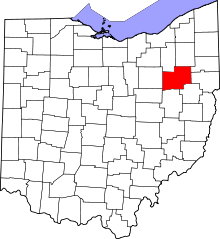Bethlehem Township, Stark County, Ohio
| Bethlehem Township | |
|---|---|
| Civil township | |
|
Former St. Paul's Reformed Church | |
 Location of Bethlehem Township in Stark County | |
| Coordinates: 40°42′44″N 81°30′14″W / 40.71222°N 81.50389°WCoordinates: 40°42′44″N 81°30′14″W / 40.71222°N 81.50389°W | |
| Country | United States |
| State | Ohio |
| County | Stark |
| Area | |
| • Total | 33.4 sq mi (86.6 km2) |
| • Land | 33.3 sq mi (86.4 km2) |
| • Water | 0.1 sq mi (0.2 km2) |
| Elevation[1] | 1,020 ft (311 m) |
| Population (2000) | |
| • Total | 5,650 |
| • Density | 169.4/sq mi (65.4/km2) |
| Time zone | Eastern (EST) (UTC-5) |
| • Summer (DST) | EDT (UTC-4) |
| FIPS code | 39-06180[2] |
| GNIS feature ID | 1086973[1] |
Bethlehem Township is one of the seventeen townships of Stark County, Ohio, United States. The 2000 census found 5,650 people in the township, 4,210 of whom lived in the unincorporated portions of the township.[3]
Geography
Located in the southwestern part of the county, it borders the following townships:
- Perry Township - north
- Canton Township - northeast corner
- Pike Township - east
- Lawrence Township, Tuscarawas County - southeast
- Franklin Township, Tuscarawas County - southwest
- Sugar Creek Township - west
- Tuscarawas Township - northwest corner
Most of the village of Navarre is located in northwestern Bethlehem Township. A very small portion of the city of Massillon also lies within the northwest portion of the township. The township also contains the unincorporated community of Smoketown within its east central portion.
Name and history
Statewide, the only other Bethlehem Township is located in Coshocton County.[4]
Bethlehem Township was described in 1833 as having two stores and two saw mills.[5]
Government
| Historical population | |||
|---|---|---|---|
| Census | Pop. | %± | |
| 1820 | 489 | — | |
| 1830 | 886 | 81.2% | |
| 1840 | 1,019 | 15.0% | |
| 1850 | 2,398 | 135.3% | |
| 1860 | 2,401 | 0.1% | |
| 1870 | 2,148 | −10.5% | |
| 1880 | 2,304 | 7.3% | |
| 1890 | 2,290 | −0.6% | |
| 1900 | 2,236 | −2.4% | |
| 1910 | 2,495 | 11.6% | |
| 1920 | 2,393 | −4.1% | |
| 1930 | 2,929 | 22.4% | |
| 1940 | 3,227 | 10.2% | |
| 1950 | 3,568 | 10.6% | |
| 1960 | 4,277 | 19.9% | |
| 1970 | 4,528 | 5.9% | |
| 1990 | 5,803 | — | |
| 2000 | 5,650 | −2.6% | |
| [6] | |||
The township is governed by a three-member board of trustees, who are elected in November of odd-numbered years to a four-year term beginning on the following January 1. Two are elected in the year after the presidential election and one is elected in the year before it. There is also an elected township fiscal officer,[7] who serves a four-year term beginning on April 1 of the year after the election, which is held in November of the year before the presidential election. Vacancies in the fiscal officership or on the board of trustees are filled by the remaining trustees.
References
- 1 2 "US Board on Geographic Names". United States Geological Survey. 2007-10-25. Retrieved 2008-01-31.
- ↑ "American FactFinder". United States Census Bureau. Archived from the original on 2013-09-11. Retrieved 2008-01-31.
- ↑ Stark County, Ohio — Population by Places Estimates Ohio State University, 2007. Accessed 15 May 2007.
- ↑ "Detailed map of Ohio" (PDF). United States Census Bureau. 2000. Retrieved 2007-02-16.
- ↑ Kilbourn, John (1833). "The Ohio Gazetteer, Or a Topographical Dictionary". Scott and Wright. p. 95. Retrieved 12 December 2013.
- ↑ census data: 1820 : 1820 page 137 , 1830 : Kilbourn, John (1831). The Ohio gazetteer: or, Topographical dictionary: describing the several ... in the State of Ohio. self. p. 332. , 1840, 1880 : Howe, Henry (1907). Historical Collections of Ohio, The Ohio Centennial Edition. The State of Ohio. p. 285. , 1850, 1860, 1870 : 1870 page 35 , 1890, 1900 : Hunt, William C. (1901). Population of the United States by states and territories, counties, and minor Civil Divisions, as returned at the Twelfth Census: 1900. United States Census Printing Office. p. 318. , 1910, 1920, 1930 : 1930 page 56 , 1940, 1950 : 1950 page 21 , 1960, 1970 : 1970 page 135 , 1990 : 1990 , 2000 : 2000
- ↑ §503.24, §505.01, and §507.01 of the Ohio Revised Code. Accessed 4/30/2009.
